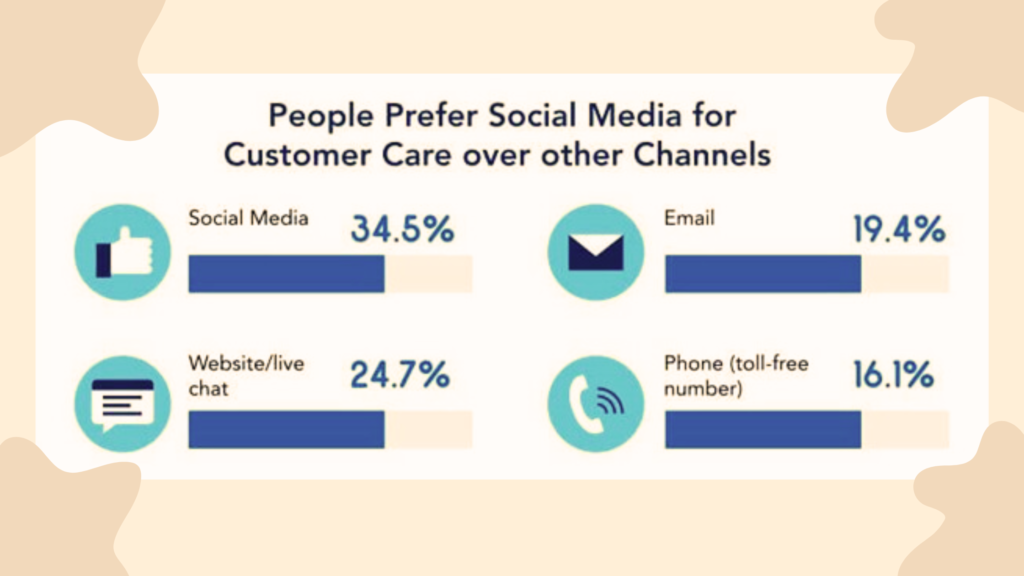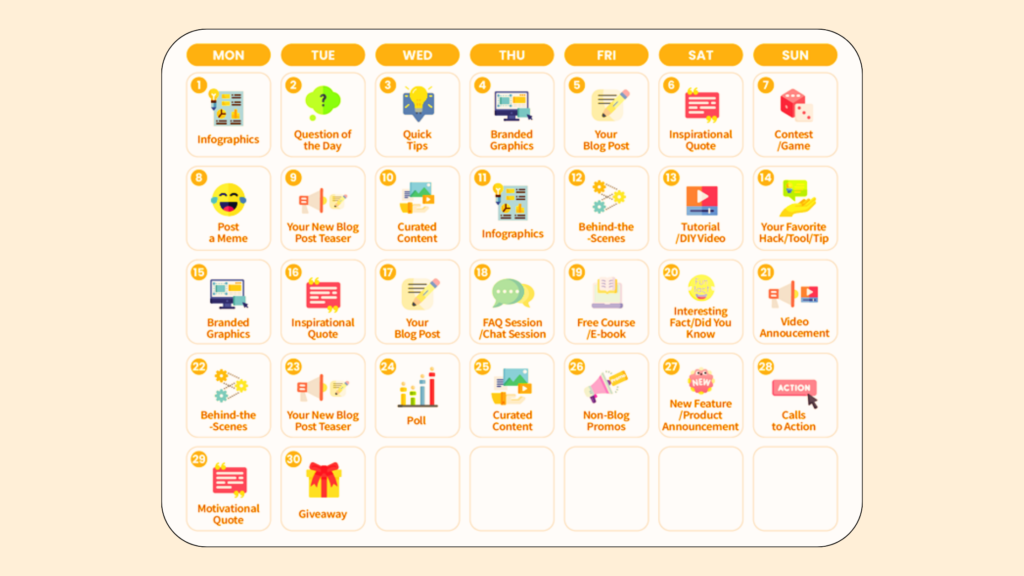Social Media Marketing: How to Do It Right?
Social media is one of the most effective channels to help you reach and connect with your target audience. Building relationships based on trust is done by communicating with them across their preferred platforms.
They spend hours and hours every day on social media, and people find out about new products or brands on such platforms.
While social media is a time-spent connecting with friends and family, 25% of those surveyed actually report seeking out new products on the likes of Facebook, Instagram, and YouTube. This gives businesses a very real opportunity to directly touch prospective customers on their social channel of choice.
In this post, we will share all the information about what social media marketing is, how it will help drive your business, and how to create a winning strategy that drives real results.
What is Social Media Marketing?
Social media marketing (SMM) is among the most vibrant ways to reach your audience, build a brand, and grow your business. It’s all about how well one strategizes a combination of great content creation, active engagement, data analysis, and targeted advertising.
Success with social media marketing needs an active approach that can offer measurable objectives. Here are the key components of SMM:
- Profile Optimization: Make sure your social media profiles are well-maintained, look cool, and are search engine optimized.
- Engaging Content: Create and publish relevant, high-quality content on a routine basis that your target audience will relate to and that composites the messaging of your brand.
- Community Building: active responding to comments, sharing, and likes, timely; attention to online reputation to maintain the positive brand image.
- Building Relationships: Interact with your followers and customers; create a community centered around your brand, as well as interactions with your influencers.
- Targeted Ads: Paid media on social media channels serves to gain greater and targeted audiences, thus achieving desired goals.
With all these varied social media platforms, not to mention robust tools for management, your business is primed for the optimal utilization of social media in achieving your goals.
Only a well-developed strategy and regular engagement with the target audience will enable you to realize the fullest potential that social media marketing can give to your business.
Know complete social media stats for better understanding – Key Social Media Channel Usage & Marketing Stats
Benefits of Social Media Marketing
With free channels and unlimited usage, social media marketing platforms provide plenty of opportunities to promote your brand. Here are some key benefits that you will leverage by implementing a fool-proof strategy:
- Enhanced brand awareness and engagement
According to the Sprout Social Index 2023, over half of the consumers surveyed claim to have used social media more in the last two years alone, a 53% increase. With billions on these social platforms, not being on social media is akin to losing a very large and potential audience.
Utilize social media to create awareness by placing links to your website or reacting to brand mentions, and sharing other offers within your profile, bio, and posts for traffic to drive directly to your site.
Build a continuous social media marketing strategy to help you build strong brand identity. You will break through the noise and connect with your target audience so much easier if you can maintain consistency across multiple platforms.
- Foster customer relationships
The interaction is the foundation of strengthening and building a reliable and continuous relationship with one’s followers of social media. Interact more with them by answering questions and responding to comments, and be of service to them so that they can feel your concern for their needs.

To build further relationships, try asking your followers questions: questions about your product, their pain points, or anything else of this nature.
That way, you show them you care by seeking their opinions or commitment to deliver a solution. Running a giveaway or contest is one of the most entertaining and really easy ways to earn trust and thank followers who come to support your brand.
- Promotes brand trust
In this case, social media has great consequences for brand trust, not least for young consumers. The most recent Sprout Pulse Survey showed that a huge 78% of consumers believe that a brand’s social media provides them with a better feeling of trust compared to a year ago.
Just as a poorly designed website would have turned consumers away years ago-those suspicious of fraud in particular-so, too, does a poorly executed social media presence today.
Inconsistent updates, conflicting messaging, or inappropriate content for the platform raises red flags and erodes consumer trust.
- Gaining competitive edge
Social media is a great way to keep tabs on your competitors — whether it’s their social media tactics, the products they’re promoting, the campaigns they’re implementing, or their level of interaction with followers.
Social media allows you to look at what is and isn’t working for your competition and, therefore, helps you decide what should or shouldn’t change regarding your company’s approach.
Lastly, reviewing your competitors’ social accounts can help you make sure your marketing stands out and is unique to your brand.
How to Create a Social Media Marketing Strategy?
And while the social media sites themselves may evolve, the fundamental concepts of good marketing do not. Creating a social media marketing strategy is truly just a niche application of broader marketing principles.
Step 1: Set goals and establish KPIs
The foundation of any successful social media strategy is to define your goals. Whether you want team growth, an increase in your following, or a more active community, setting clear objectives marks the beginning of such success.
In building up a focused social media marketing campaign, set SMART goals-that is, specific, measurable, attainable, relevant, and time-bound. This sets the direction and lays the basis for the measurement of success in terms of outcomes and return on investment.

The goals you determine will decide on the KPIs to track and what resources to use in the campaigns. Where possible, consider different goals for tracking on various social media channels or even for various uses of each channel.
You might run paid campaigns for awareness, for example, and track acquisition and engagement metrics more for organic social posts. In order to get the most from your social media goals, set them in alignment with your greater marketing strategy.
Step 2: Understand Your Potential Audiences
Consequently, understanding the audience and what they are looking for from you on your social media empowers you to create the content that resonates with them and drives engagement. It becomes even more valuable to turn your social media followers into loyal customers.
Indeed, developing audience personas really refines marketing tactics. Personas open the door to a much deeper realization of what stirs their customers’ desires, motivations, and preferences so that you may be able to identify those needs with pinpoint accuracy using your campaigns.
In all, social media analytics provide a great deal of insight into who your followers are, what they’re interested in, and how they interact with your brand online.
You’ll be able to use these combined insights to refine your strategy, better target your social ads, and create content that really resonates with your audience.
Steps 3: Deciding the Suitable Social Media Platforms
With that said, every social media marketer should select a channel that best fits the needs and preferences of their target audience. Consider where they hang out online and what kind of content they like.
For example, TikTok mostly have Gen Z audience which makes it a perfect social media marketing platform. By being present on the platforms where your audience already is, you will be able to raise the level of engagement and effectiveness of reaching your audience.

Basically, while choosing the platforms, consider their strengths and specializations. For video content, for instance, consider YouTube or Instagram Reels.
However, this does not mean you need to confine your choices to the best-fit channels. Being on more than one platform will allow you to expand your circle and help you experiment with various formats and types of social media content.
Steps 4: Analyze your Competitors
A competitive analysis will also give insight into your competitors’ strategies, strengths, and weaknesses. Once you understand what they do well and where they fail, you can set informed social media goals for your business.
You can also use competitive analysis to identify opportunities that no one is fully exploiting. If you happen to see there is a competitor dominating on one platform and leaving others unserved or underserved, then you may be able to fill in the gaps.
Other powerful tools for competitor tracking are social listening. By monitoring their accounts, as well as industry keywords, you’ll stay on top of strategic shifts that they make and where you may want to improve your own social media.
Step 5: Creating a Social Media Content Calendar
The basis of any good social media marketing is a coherent and well-thought-out presence across your selected platforms. Rather than posting on a whim, one should create something called a content calendar, used to schedule content ahead of time.
Below is a sample for a social media content calendar that can be customized according to your goals and brand message:

Here’s how to set up a successful content calendar:
- Brainstorm content ideas: Create a mix of content ideas that best fit your content pillars and resonate well with your target audience.
- Focus on best publishing times: Under each social network, research the days and hours of the day when publishing can receive more engagement and reach.
- Plan for special event: Dates of events, new product announcements, or other company news can be scheduled well in advance for posting to capture the attention at highest levels.
By mapping out your social media content in these ways, and through your existing pillars of content and formats, it’s easy to create a consistent online presence that’s truly engaging.
Steps 6: Distribute Audience-focused Content
With billions of profiles and active users on social media, it becomes impossible for your followers or potential ones not to be exposed to a variety of content provided by either direct competitors or businesses in their subject of operation.
In all these, if you want to attract more new followers, your content should be engaging enough and make them compelling. That means creating content that will capture the attention, increase relevance, and will lead users to hit the “Follow” button and drive them to engage with the brand.
Social media algorithms often ensure your posts appear to those users who will be interested in them. Create creative content by studying what competitors have already published and brainstorming unique ways to push your products.
Utilize user-generated content like customer reviews, ratings, and testimonials to foster trust and drive conversions.
Steps 7: Track Social Media Metrics and KPI
Any social media strategy, be it for any industry or any objective, must be engrossed in data. This means instead of the vanity metrics, you focus on the metrics that align directly with your goals.
Here are the key social media metrics you should be tracking consistently:
- Reach: The number of unique users who viewed your post. This signifies how well your content is reaching its target audience.
- Clicks: The total number of clicks on your content or account. By tracking the number of clicks per campaign, it will provide a greater understanding of what provokes curiosity and encourages them to act.
- Engagement: The total number of social interactions divided by the number of impressions. It is a metric to show how much perception your audience develops about your brand and its content.
- Hashtag Performance: Look at the most-used hashtags, usage, and association with a brand. It may serve useful to revise the strategy of content creation and targeting the ideal set of audiences.
- Organic vs. Paid Likes: Master the art of knowing how much was organic and how much was paid, to maximize ad spend and content creation efforts.
- Sentiment: Find out how your users are feeling about your content, brand, and hashtags so you may improve the areas where the sentiment is negative.
By focusing your attention on these key metrics, analyses within those data items will assist in driving decisions toward the optimization of your social media strategy.
Best Social Media Marketing Platforms
We have made a list of top social media marketing platforms that can help you understand their purpose and how you can use these channels to reach your brand objectives.
1- Facebook
It is the biggest social network worldwide and among the biggest local business directories. People of every age group use the website to stay in touch with friends and family members, join communities that reflect their interests, find businesses near their locations, and follow brands.
For businesses, there is a range of possibilities on Facebook:
- Customer relationship building: Connect with your customers, retain the loyalty of existing ones, and offer them good customer service.
- Plan for announcements: This could be anything like a change of hours, upcoming events, or any other achievements.
- Discussions & streaming: Engage with your audience through discussions, live streams, and Q&A sessions that will keep in contact with your customers and community building.
- Baby Boomers: Because they are the most engaged demographic on Facebook, one could reach the baby boomer generation.
By effectively leveraging the features and capabilities of Facebook, businesses can foster strong relationships, build brand awareness, and drive growth.
2- Instagram
Despite being a relatively new platform compared to LinkedIn and Twitter, Instagram quickly gained immense popularity and reached one billion monthly active users in 2018. Its diverse content formats, including Feed posts, Stories, Lives, Reels, and IGTV, have contributed to its widespread appeal.
To maximize your Instagram presence, create a compelling bio and leverage the platform’s features for:
- Social shopping: Instagram Business feature can help you showcase your products and services, enabling users to easily discover and purchase them.
- Influencer marketing: Collaborate with influencers who resonate with your target audience to promote your brand and reach new customers.
- User-generated content: Encourage your followers to share their experiences with your brand, fostering a sense of community and authenticity.
- Company culture: Showcase your company’s culture, values, and behind-the-scenes glimpses to connect with your audience on a deeper level.
Instagram is a platform where people follow influencers and brands that align with their personal values and interests. Users often discover and purchase products and services through Instagram.
3- TikTok
TikTok grew quicker than any social network, ever. In five years, it gathered a colossal one billion monthly active users. It is now crystal clear why businesses have started to see its potential as a marketing channel, but at the very core of TikTok lies its main purpose: entertainment.
To effectively use TikTok for business, ensure your content coincides with both entertainment and marketing objectives. Following are the keys for the same:
- Trending Challenges: Participate in trending challenges to increase visibility and larger outreach.
- Create entertaining and motivating videos: Hilarious and inspiring content is most likely to attract TikTok users.
- Relatable: Create content with your audience that they relate to and create value from.
Following these strategies provides you with an efficient TikTok to reach out to your target audience, create brand awareness, and drive business.
4- YouTube
Although YouTube is primarily used video-centric channel, it isn’t any less of a social media marketing platform. The users can share their content in the form of videos, like other users’ videos, comment upon them, or share them with other people to grow their YouTube channel.
Moreover, any user can also follow any account he finds compelling. YouTube also offers customized feeds that try to recommend different content based on preference.
The following will be some of the effective strategies:
- Tutorials, how-to, and explainer videos: YouTube is an excellent medium to convey information for learning something new or understanding complex matters.
- YouTube Live Streams: Now, you could sell products or services right from within a live video feed and have viewers purchase directly.
- Ads: Run the YouTube ad options like video and display to reach more and create awareness about your brand.
- YouTube SEO: Search engine optimization of your YouTube videos will have them show up better in results, especially for “how-to” queries.
Unlike most social media platforms, going viral isn’t actually the key to success on the platform. The most important value from the platform is derived by offering something useful to your audience.
5- Twitter
Twitter’s format allows for fast, concise communication; thus, it is a major place for sharing ideas, news, and discussions. People listen to Twitter as a means of information, connecting them with brands and customer support in many instances.
Considering these aspects, some ways to extend reach and engagement on Twitter are listed below:
- Retweet Positive Feedback: Showing appreciation for positive comments from customers by retweeting helps in building trust and reputation.
- Address Questions and Conversations: Show great customer service through answering questions and, where possible, solving problems as swiftly as possible.
- Influencer Tracking: Keep your finger on the pulse of the latest news within your industry and trending topics by following influential accounts within your niche.
- Threaded Storytelling: A story can be told in several tweets that are threaded together.
- Respond to Customers and FAQs: Answering customer queries; answering FAQs to help improve customer satisfaction.
By applying these techniques, you will surely be able to use Twitter to leverage the attention of your audience and drive engagement toward the realization of your marketing objectives.
6- LinkedIn
Not only is LinkedIn a professional networking platform, but it’s also a community that aspires to and nucleates leadership, learning, and shared values. This makes it an ideal social media platform to showcase your company culture and build your personal brand along with your business brand.
Here are the LinkedIn marketing strategies you should implement:
- Hire the Best: Highlight your company culture, values, and career opportunities as a means to attract top talent.
- Networking with Partners, Peers, and Customers: Let the industry professionals, potential partners, and customers learn about you.
- Share Company Milestones and Culture: Share milestones reached, company events, and your company culture.
- Publish Industry News and Insights: Give value by posting content regarding your industry.
With LinkedIn, you have a whole suite of possibilities you can use to extend your company’s presence and engage your audience. You can create an online presence for your brand, position and present your company as a thought leader, or build business.
Social Media Marketing Tips
Now that you know which platforms are superior to implement social media marketing strategies. Here are some proven tips to implement your strategies more effectively:
1- Focus on Value-added Content
Just like with any other online marketing channel, on social media, too, the king is content. To be able to keep your audience engaged and ensure effective results, posting frequency at relevant information that speaks to your ideal customers is crucial.
Following are some of the most engaging content types that work well on social media:
- How-to and Quick Tips: In this regard, you may share practical advice and guidance concerning your industry or products.
- News about Locality and Industry: Share news and updates related to their interests.
- Data and Insights: Attach some valuable insights and statistics to the content being shared, proving a certain degree of expertise.
- Polls, Questions, Contests: Engage the audience by asking them interesting questions and even holding contests.
- Updates and Announcements: Publish the latest news and updates that might relate to your company, its products, or services.
You will ultimately obtain better audience engagement, increase awareness of your brand, and drive more conversions from your social media channels if you consistently make sure your audience receives value through different kinds of formats.
2- Optimize Your Feed For Better Outlook
While the majority of us focus on being seen, there is a lot we could learn from our feed. By following your competitors, influencers, and brands that resonate with your values, you’ll be able to do the following:
- Competitor monitoring: understand their strategies, see where the opportunities lie, and know what is missing in the market.
- Trend watching: follow influencers for up-to-date information on industry trends and best practices.
- Take inspiration: find out which brands have effective content strategy and learn something new.
3- Consistently Engage with Your Audience
Social media sites are all communities, and that is built on active engagement to foster and strengthen relationships for loyalty.
- Comment Response: Comments and questions are ways of appreciation that can be well appreciated through quick responses.
- Like, Share, and Comment: Like, share, and comment on other users’ content to keep in touch and increase visibility.
- Live Streaming: Go live with your audience for a real-time interactive discussion and Q&A.
- Run Polls and Ask Questions: Engage the audience in some way to participate and provide something worth giving feedback on.
- Repost Others’ Content: This is a great way to show support for other people’s content in return for reaching a larger audience.
4- Repurpose Content for Efficiency
Repurposing content is one of the best ways to create more social media content without burning out your team. Reusing existing content will enable you to achieve the following:
- Time and Effort Saved: Avoid the constant pressure to produce content.
- Wider Audience Reach: Publish your content in other formats to various platforms.
- Engagement Increase: Display new angles not previously presented in this piece.
5- Leverage Paid Social for Targeted Reach
Paid social media ads are super effective at extending your reach, and improvements in targeting mean you can reach highly granular targeting and easily budget your money for maximum ROI.
- Facebook Ads: Utilize Facebook’s robust targeting options to reach out to potential customers based on their demographics, interests, and behaviors.
- Pinterest Ads: Advertise your product or service to visually engaged audiences on Pinterest.
- Instagram Ads: With visually appealing ads on Instagram, it’s easier to help showcase your brand and its products.
This, in turn, can be utilized to develop a better presence in social media, interact with the audience, and drive meaningful results for your business.
Leverage Brand-focused Social Media Marketing from eSearch Logix
The successful construction of a social media marketing strategy requires critical and strategic thinking. Knowing your target audience, defining goals, using the right platforms, developing content with impact, and putting analytics to work for you will be major milestones toward achieving your business objectives with social media.
At eSearch Logix, we have been able to guide businesses in working towards their goals using social media marketing. Our team of experienced professionals will be able to help with the following:
- Full Social Media Strategy: Creating a personalized strategy that aligns with your business objectives and target audience.
- Content Creation and Management: The development of high-quality, engaging content that resonates with your target audience.
- Social Media Advertising: Optimize your advertising campaigns for the right people and drive results.
- Community Management: Nurture your online community through effective engagement.
- Analytics and Reporting: Track your performance, provide actionable insights that help you improve your strategy.
Come onboard with eSearch Logix, and open up to the whole gamut of social media marketing to drive your business. Give us a call today to find out how we can partner with you in achieving your goals.







